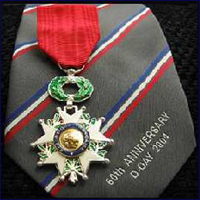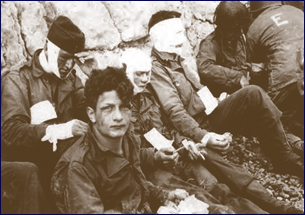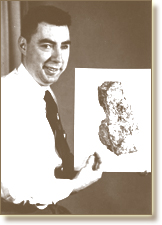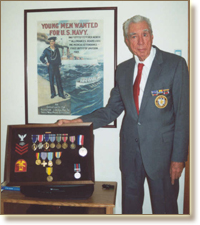U.S. Navy veteran John Gallagher (1924-2004) was a communications expert with special amphibious forces during WWII.
As a First Class Radioman in the 6th Naval Beach Battalion, John's shore-to-ship messages on D-Day June 6, 1944 were
responsible for getting troops and materials across the invasion beaches of Normandy. After sustaining a serious
injury on D+1, a famous photo of John was taken, with head heavily bandaged, patiently awaiting casualty evacuation
from "bloody" Omaha Beach.
Sixty years after D-Day, still filled with shrapnel and wearing a glass eye, John Gallagher and shipmate Dr. Richard
Borden returned to Normandy, by special invitation of the French Government, to receive the country's highest award,
the prestigious Legion of Honor. John died five months later and is buried in Hopewell Junction, NY. His loving son,
Glenn Petersen, accompanied John overseas and shot the photo below in France.


A long time resident of Dutchess County, John Gallagher worked for East Fishkill IBM before retiring in 1984 and
moving upstate to Sidney, NY. Reprinted with permission from the author, the following Veterans Day story was
published in the November 6, 2002 issue of The Tri-Town News.
By Denise Marshall
John Gallagher of Sidney was 17 years old in 1942 when the request came for 3rd Class Navy radiomen and signalmen to
volunteer for the "Beach Party." He remembers asking what they meant by a "beach party," and the reply "wine, woman
and song" from the chief boatswain. While the November 8, 1942 landing of the USS Dorothea Dix at Safi, French
Morocco in North Africa was definitely no party, it paled in comparison to the action he would see two years later
as a 1st Class radioman in the 6th Naval Beach Battalion serving with the Army's 5th Engineer Brigade at Omaha Beach,
Normandy. Some 57 years of "classified silence" about that D-Day invasion have now been broken, but the suffering is
not soon forgotten by John and fellow survivors.
While the film "Saving Private Ryan" played a big part in breaking the silence, and the lengthy process of
facilitating presidential citations between the departments of the Navy and Army finally achieved results in August
2000, Gallagher has literally been "carrying the weight" of the battle details, including the shrapnel, for years
since he was discharged from the Navy in the mid 1950's.
"I didn't want to see "Saving Private Ryan," Gallagher confesses. "It's still too painful. But, they sent me the tape
and I have to say that the first twenty minutes is quite accurate. There was much that could not be shared, like the
fact that bulldozers were there by late afternoon, burying bodies before the reinforcements arrived and saw them."
For Gallagher, the two presidential citations, from the Navy for action in 1942 and the Army for 1944, as well as the
French Croix de Guerre and the Purple Heart for the 1944 action, take a back seat to the "surprise" mirrored plaque
presented [by shipmate Frank Snyder] Sunday, September 29, 2002 at the 13th annual reunion of the Sixth Naval Beach
Battalion held in Atlanta, Georgia.
Etched in the corners with symbols of the medals he received, the plaque reads, "If anyone ever questioned the
existence of a divine being, the answer is given by John Gallagher's presence here tonight. Among the first to
land on Omaha Beach, Normandy, France, D-Day, June 6, 1944, John had hardly reached the shore under heavy enemy
fire when he suffered a grievous injury which would have destroyed any lesser man. That he survived that wound and
has endured the struggle of ensuing years is testimony to his will and indomitable spirit."
That same spirit was no less praised by the attending doctor, J. Russell Davey, who, in a letter to his wife, Mary,
dated July 29, 1944, wrote "I met one of our Enlisted Men who had just arrived from an Army Hospital. He had had a
2.3 cm piece shrapnel enter his face just below the eye, which passed thru the upper part of the maxillary sinus,
entered the orbit to sever the optic nerve and lodged in the petrous part of the temporal bone. One unsuccessful
attempt to remove the shrapnel was made. Perhaps you would expect that these cripples would be bitter and
resentful. They are not, nor are most of the others I've talked to. They're just very, very happy to be alive.
The only regret was from the first eye case. [Gallagher] He is regular Navy and wanted to make a career of the
service. (Of course he will now be surveyed out.) I have found the morale of these casualties is excellent. But
no less excellent than their courage and patience immediately after receiving their wounds. That latter was a
big help to those of us trying to care for them."


In the June 2002 issue of the National Geographic, John is pictured among the wounded on Omaha awaiting evacuation,
his face covered with bandages. Another of his battalion, beachmaster for Easy Red Beach, Joseph P. Vaghi '42D, who
has been instrumental in the placement of a plaque placed at Omaha Beach honoring the fallen of the 6th Naval Beach Battalion, was also interviewed in the National Geographic article and presented with the mirrored plaque at the reunion. Every battalion member received a replica of the plaque placed at Omaha Beach [authored by Vaghi] which reads, "The officers and men of the 6th Naval Beach Battalion dedicate this plaque to our fallen comrades who gave their lives in defense of good over evil. They are the silent sentinels who from their final resting place above the cliff perpetually watch over the sacred ground of Omaha Beach. June 6, 2001."
As the presidential citation reads, "At 0735 hours on the morning of 6 June, 1944, the first elements of the 6th Naval
Beach Battalion reached the beach. Underwater obstacles and enemy artillery damaged or sank most of their landing
craft, losing valuable equipment and forcing personnel to swim for shore under hostile fire. Assault troops were
pinned to the beach by murderous fire from enemy rifle, mortar, machine gun and artillery emplacements. Officers
and men of the battalion worked along the side of gap assault teams in clearing obstacles so supplies and troops
could cross the tidal flat of the beach. Other elements helped build up a firing line and set up control stations
on the beach to direct the landing crafts. Safe lines of approach were marked and ship-to-shore communication
was established. Movement on the beach was made hazardous by enemy fire and mines which had become detached
from obstacles and buried in the sand. During the night, the beach was strafed by enemy aircraft and the
imposed blackout hampered the battalion's activities. The extraordinary gallantry, heroism and determination
displayed in overcoming unusual difficulties and hazardous conditions and the esprit de corps displayed by
the 6th Naval Beach Battalion contributed materially to the capture of Omaha Beach and reflect highest
credit on personnel of this organization and the Armed Forces of the United States."
A licensed HAM radio operator since the age of 14, John's job at Omaha Beach was a radioman, establishing
communications between the beach and the ships in the harbor waiting to land the invasion force. His experience
with electronics later landed him a job with IBM where he worked until 1984, moving to Sidney after his retirement.
Due to his exceptional expertise, IBM recruited him at the age of 32, making an exception to their own age rule. It
was while working at IBM that he lost two pieces of the shrapnel in his head, one after a coughing spell when he could
have choked on it save for the quick action of a nearby ex-Marine and another, 14 years later, when he, not having
any feeling in that side of his face, didn't realize a piece had fallen and was lodged in his gums causing blood to
stream down his face.
While other highlights of the 2002 reunion included sharing the experience with his son, being served their meal by
a four-striped Captain, full commander and lieutenant commander at the Atlanta Naval Air Station who said "We owe it
to you for your service to your country," and receiving Diplomas of Appreciation from the government of France
presented by French Consul General Rene Marty, the big push for John is to be one of these survivors of the
fighting "sons of beaches" who celebrates the 60th anniversary reunion at Normandy, France in 2004.
In the meantime, those of the Tri-Town area join the rest of the nation in saluting the courage and commitment of
John Gallagher and those who have served their country in the Armed Forces.


John Gallagher pauses among mementos of his precious service to the United States Navy in the photo by The Tri-Town
News author Denise Marshall. Back in 1957 when he worked at IBM, John holds an enlarged photo in one hand while the
actual shrapnel is in the other. This piece, and another which came loose 14 years later, had been lodged in his head
since D-Day as he lost his eye when hit by the shrapnel from a German artillery shell.
 Back to Top
Back to Top











